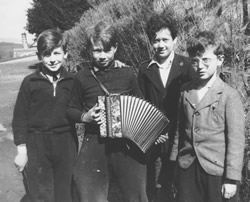
Henri Zang, Max Spiro, Egon Drab, and Kurt Deutsch in the Priory, a children’s home in Selkirk Scotland, 1940. Photo courtesy of the USHMM
Children who had prearranged sponsors waiting for them were sent to London and towns throughout Britain. The many unsponsored children waited in Dovercourt, a summer holiday camp, and other transient camps until individual families came forward to take one or two children into their homes, and hostels were readied to take larger group of children. Many organizations and individuals assisted in settling the Kinder in the United Kingdom, including the Refugee Children’s Movement, the B’nai B’rith, the Chief Rabbi’s Religious Emergency Council, various youth movements, the Y.M.C.A., the Society of Friends, and many other Jewish and non-Jewish organizations. Private gifts of money, bedding, and clothing were received as well as offers of foster homes and houses for possible group homes.
Children of the Kindertransport were dispersed to many parts of the British Isles. About half lived with foster families, the others in hostels, group homes, and farms in England, Scotland, Wales and Northern Ireland. Those older than fourteen, unless they were fortunate enough to be sponsored by individuals and set to boarding schools or taken into foster care, were frequently absorbed into the country’s labor force after a few weeks of training, mainly in agriculture or domestic service.
Many families, Jewish and non-Jewish, opened their homes to take in these children. Many of the children were well-treated, developing close bonds with their British hosts; however, others were mistreated or abused. Some were interned as “enemy aliens.” A number of the older children joined the British or Australian armed forces as soon as they reached eighteen years of age and joined the fight against the Nazis. Most of the children never saw their parents again.